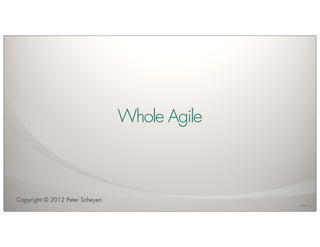Whole Agile
- 1. Whole Agile Copyright ÂĐ 2012 Peter Scheyen Version 1.0
- 2. PERSONAL BACKGROUND Peter Scheyen (pscheyen@gmail.com, @pscheyen) CTO, Richard Ivey School of Business Formerly with Comcast, TVWorks, Liberate, Cableshare Experience includes Software Developer, Management, VP Eng Traditional software development methodologies Introduced Agile methods in different contexts Small team of 10 members Large organization of 10 teams of 5-10 members each
- 3. Whole Agile Version 1.0
- 4. COMMON PERCEPTIONS OF AGILE METHODS
- 7. No More Project Managers No PMs? No QA?
- 8. Change Orders for Free Free Changes?
- 9. Cowboy Coding? Cowboy Coding
- 10. For Elite Programmers Only Requires Elite Programmers?
- 11. For Web Development Only Web Programming Only?
- 12. For Small Teams Only Small Teams Only?
- 14. WHY BOTHER?
- 15. Deliver working software faster and more frequently
- 17. Self-managing, adaptive, learning teams
- 18. Less reliance on individual heroes Greater reliance on high performing teams
- 19. More effective use of resources
- 20. Can create space for organic innovation
- 21. Higher visibility into the true state of projects
- 22. No place to hide
- 23. WHAT IS AGILE ANYWAY?
- 24. A BRIEF HISTORY Iterative methods date back to the 1950s Object oriented programming from the 1960s Adaptive methodologies from the early 1970s Lightweight methods developed in the 1990s Agile Manifesto signed in early 2001 Scrum, XP, Crystal, Adaptive Software Development, FDD
- 25. AGILE MANIFESTO We value: Individuals and interactions over processes and tools Working software over comprehensive documentation Customer collaboration over contract negotiation Responding to change over following a plan http://agilemanifesto.org
- 26. IN A NUTSHELL Working software product as the primary deliverable Iterative and incremental product development Close collaboration between customer/business and technical roles Dave Rooney, âAn Organizational Structure for Agile Projectsâ
- 28. WHAT IS âWHOLE AGILEâ? Successful agile is more than... working software delivered iteratively in collaboration with customers a set of processes a set of software development practices Whole Agile looks at the organization as a system taking into account not only Process but also People, Culture, Communication, Physical Environment, Requirements, Organizational Roles
- 29. ESSENTIAL ASPECTS OF WHOLE AGILE
- 30. ESSENTIAL ASPECTS OF WHOLE AGILE Basic Agile Practices Software Development Practices Culture People Organization and Roles Communication Feedback and Adaptation
- 31. ASPECT: BASIC AGILE PRACTICES Backlog of remaining work Iteration planning Short, frequent meetings (daily standups) Available customer or customer representative (Product Owner) Burn down charts or similar progress tracking Deliverable software at the end of each iteration Retrospective
- 32. ASPECT: SOFTWARE DEVELOPMENT PRACTICES Out of scope for this discussion Important to trust the technical team to decide
- 34. ASPECT: CULTURE Agile Cultural Norms Whole Team Customer Value-Oriented Honesty Transparency Trust Commitment Excellence Sustainable Pace Hunger for feedback Continuous Learning Adaptable Accountable
- 35. ASPECT: PEOPLE Alistair Cockburn: ânon-linear, ïŽrst-order components of software developmentâ People are: sensitive to communication timing and modality inconsistent over time variable day to day and place to place good citizens that want to do a good job
- 36. ASPECT: PEOPLE Leadership - it takes courage Frequency and impact of decisions increased Empowerment and trust Holding people accountable
- 37. No place to hide
- 38. ASPECT: ORGANIZATION Key Roles (Dave Rooney, âAn Org. Structure for Agile Projectsâ) Customer or Customer Proxy Coach Subject Matter Expert Generalizing Specialist QA Comptroller Organizational Structure pseudo-matrixed Dual Career Paths
- 39. ASPECT: COMMUNICATION High bandwidth Open and honest Directly with customer Transparent at all levels Real-time as possible Meetings
- 40. ASPECT: FEEDBACK AND ADAPTATION Culture demands constant feedback and adaptation Relentless identiïŽcation and elimination of waste Self-assessment through retrospectives Guided by metrics (generated automatically) Peer feedback Experimentation and feedback (failure is an option) Feedback isnât enough alone -- adaptation
- 41. OTHER WHOLE AGILE ASPECTS Physical Environment Tools Portfolio management Simplicity Just enough, just in time, just do it
- 42. LEAN THINKING Lean Software Development -- Mary and Tom Poppendieck Borrows heavily from Toyota Production System 7 Principles Optimize the whole Eliminate waste Build in quality Learn constantly Deliver as fast as possible Engage everyone Keep getting better
- 43. IN SUMMARY (10 min) Software companies want to deliver more, faster Non-software companies want to better leverage IT resources Whole Agile means: Iteratively deliver working software in collaboration with the customer PLUS Whole Team Deep commitment to delivering customer value Healthy culture Open and honest communication and transparency Feedback and adaptation Relentless elimination of waste
- 44. READING LIST http://scheyeniam.blogspot.com/2012/01/agile-reading-list.html












































